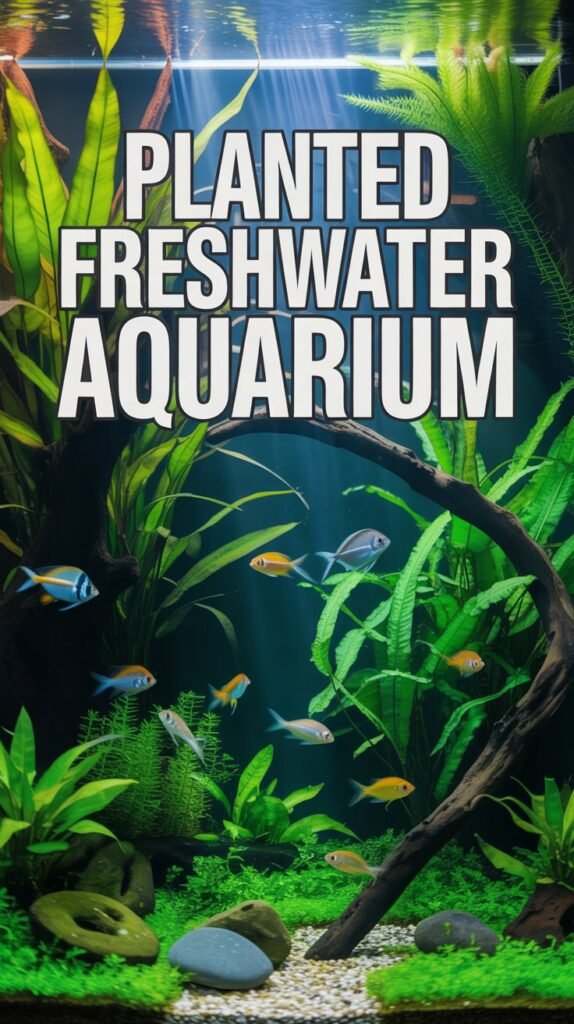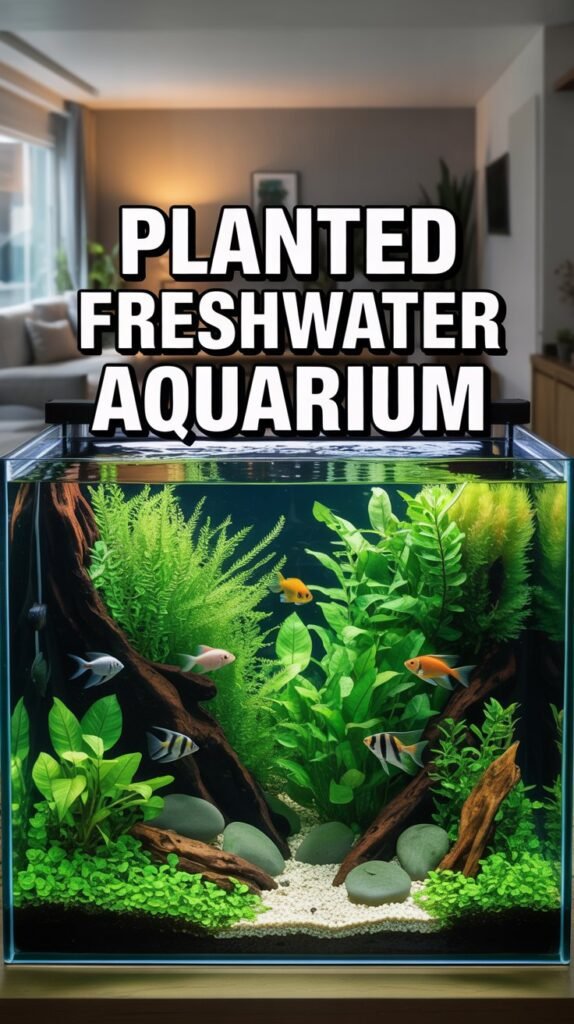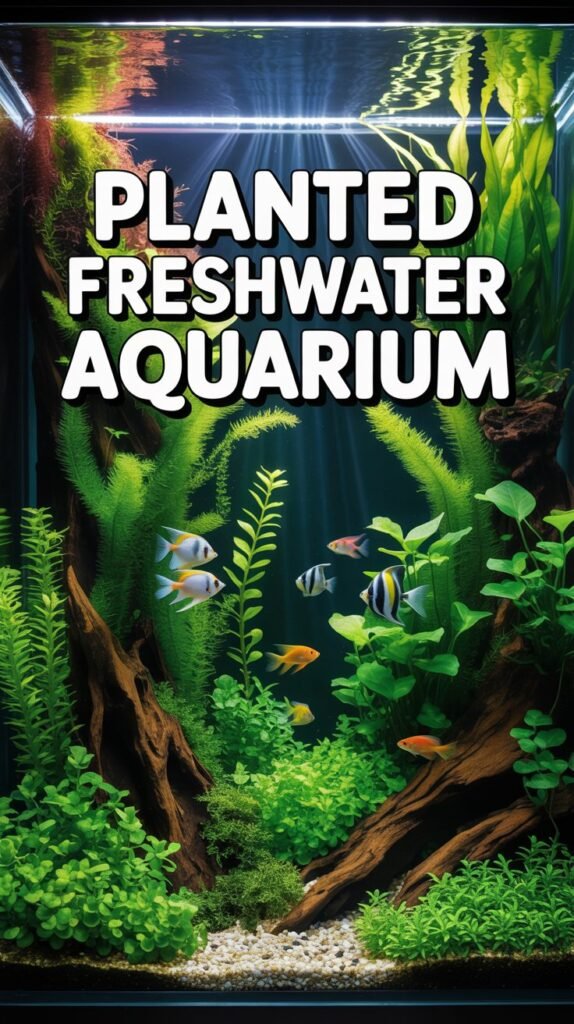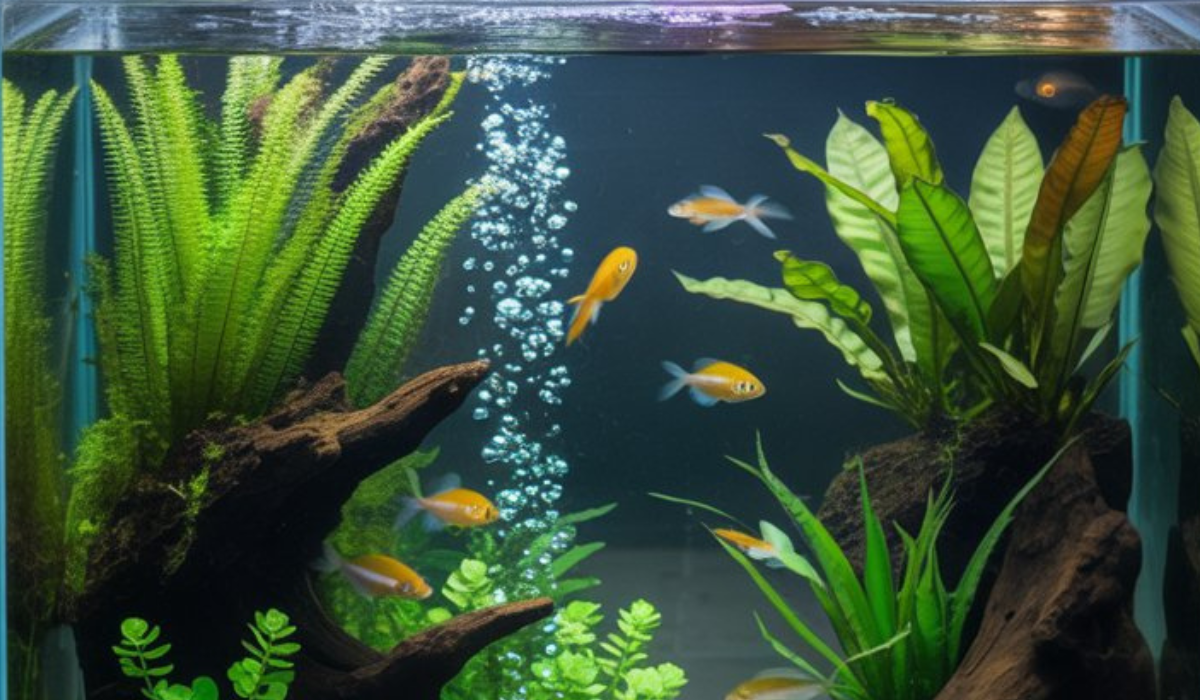A planted freshwater aquarium is more than just a tank filled with water and fish — it’s a living, breathing ecosystem. Lush green plants, colorful fish, and balanced water chemistry combine to create a stunning underwater world that’s both visually beautiful and biologically stable.
Whether you’re a beginner setting up your first tank or an experienced aquarist looking to improve your aquascaping skills, this comprehensive guide covers everything you need to know about creating and maintaining a planted freshwater aquarium — from plant selection to lighting, CO₂, fertilization, and ongoing maintenance.
1. What Is a Planted Freshwater Aquarium?
A planted freshwater aquarium is an aquarium setup that includes live aquatic plants growing naturally in water alongside fish and other aquatic species. These plants serve both decorative and functional roles — enhancing aesthetics, producing oxygen, and maintaining water quality.
Unlike artificial plants, live aquatic plants grow, reproduce, and interact with their environment, creating a self-sustaining and balanced ecosystem.
2. Benefits of a Planted Freshwater Aquarium

There are many reasons why aquarists love planted tanks. Besides looking beautiful, they bring ecological and biological benefits to the aquarium.
A. Improves Water Quality
Live plants absorb carbon dioxide (CO₂) and waste nutrients like ammonia, nitrite, and nitrate, which helps stabilize water conditions and reduces the need for frequent cleaning.
B. Provides Natural Filtration
Plants act as biological filters, removing toxins from the water and reducing algae growth by competing for nutrients.
C. Enhances Oxygen Levels
Through photosynthesis, plants release oxygen during the day, keeping the water well-oxygenated for fish.
D. Reduces Fish Stress
A lush, natural environment mimics a fish’s wild habitat, offering hiding places, shade, and comfort — reducing stress and improving overall health.
E. Promotes Natural Behavior
Fish display more vibrant colors and natural behaviors in a planted tank, such as schooling, foraging, and territorial interactions.
F. Aesthetic Appeal
A planted freshwater aquarium is like a living piece of art — dynamic, colorful, and relaxing to watch.
3. Planning Your Planted Freshwater Aquarium
Before setting up your tank, planning is crucial. You need to decide on the size, layout, and type of plants and fish you want.
A. Choose the Right Tank Size
A larger tank (20 gallons or more) is more stable and easier to maintain than a small one. Beginners are often more successful with mid-sized tanks because they’re less sensitive to water fluctuations.
B. Select the Right Location
Place your tank:
- Away from direct sunlight (to prevent algae growth)
- Near a power outlet
- On a stable, level surface
C. Decide on the Theme or Aquascape
Common aquascaping styles include:
- Nature Aquarium – mimics natural landscapes
- Dutch Style – focuses on dense plant arrangements and color contrast
- Jungle Style – wild, overgrown look with tall plants
- Iwugami Style – minimalist, stone-based layout
Having a vision helps you choose the right plants and layout.
4. Essential Equipment for a Planted Freshwater Aquarium

A healthy planted tank requires the right tools and equipment. Here’s what you need:
A. Aquarium Tank
Glass or acrylic — choose a size appropriate for your space and experience level.
B. Lighting System
Light is crucial for photosynthesis. Choose full-spectrum LED or fluorescent lights designed for plant growth.
Ideal lighting range: 6,500–8,000 Kelvin.
C. Filtration System
Use a gentle filter that promotes water movement without uprooting plants.
Popular options include:
- Sponge filters (for small tanks)
- Canister filters (for medium to large tanks)
- Hang-on-back filters (for beginners)
D. CO₂ System (Optional)
Plants need CO₂ for photosynthesis. A CO₂ injection system can enhance plant growth and coloration, especially for advanced setups.
E. Substrate
Choose a nutrient-rich substrate that supports root development. Examples:
- ADA Aqua Soil
- Fluval Stratum
- Seachem Flourite
- Eco-Complete
F. Heater and Thermometer
Most freshwater plants and tropical fish thrive at 24–27°C (75–80°F). Maintain a stable temperature with a reliable heater.
G. Water Test Kits
Essential for monitoring pH, ammonia, nitrites, nitrates, and hardness.
5. Selecting Plants for Your Freshwater Aquarium
Choosing the right plants is the foundation of a successful planted tank. Beginners should start with hardy species that tolerate a wide range of conditions.
A. Easy Beginner Plants
- Java Fern (Microsorum pteropus)
- Low light
- Doesn’t require CO₂
- Can be attached to rocks or driftwood
- Anubias Nana
- Slow-growing
- Low maintenance
- Excellent for foreground or midground
- Amazon Sword (Echinodorus amazonicus)
- Medium light
- Great for larger tanks
- Cryptocoryne Wendtii
- Low to medium light
- Beautiful leaf textures
- Hornwort (Ceratophyllum demersum)
- Fast-growing
- Helps control algae
B. Intermediate and Advanced Plants
- Dwarf Baby Tears (Hemianthus callitrichoides) – Requires CO₂ and high light.
- Rotala Rotundifolia – Red hues with strong lighting.
- Ludwigia Repens – Adds vibrant red color.
- Monte Carlo – Carpet plant for high-tech setups.
C. Plant Placement Zones
- Foreground: Carpet plants like Monte Carlo or Dwarf Hairgrass.
- Midground: Java Fern, Cryptocoryne.
- Background: Vallisneria, Amazon Sword, Ludwigia.
6. Setting Up a Planted Freshwater Aquarium: Step-by-Step
Now that you have your equipment and plants ready, let’s build your underwater garden!
Step 1: Clean the Tank
Rinse the tank with clean water. Avoid soaps or chemicals.
Step 2: Add the Substrate
Add 2–3 inches of nutrient-rich substrate. Create slopes for depth and visual interest.
Step 3: Hardscape Placement
Add rocks, driftwood, or decorations before planting. This prevents uprooting plants later.
Step 4: Fill Partially with Water
Fill about 30–40% of the tank using dechlorinated water. Pour slowly to avoid disturbing the substrate.
Step 5: Planting
- Use aquascaping tweezers for precision.
- Bury roots gently.
- Mist plants to keep them moist during setup.
Step 6: Fill the Tank
Slowly fill the tank completely. Use a plate or bowl to diffuse the water and prevent substrate disturbance.
Step 7: Start the Filter and Heater
Run your equipment and ensure everything is functioning correctly.
Step 8: Add Fish Later
Allow the tank to cycle for 2–3 weeks before introducing fish. This builds beneficial bacteria and stabilizes water conditions.
7. Lighting Requirements for Planted Tanks

Light is the energy source for plant growth. Too little light causes plants to wither; too much can cause algae blooms.
Recommended Lighting Duration:
- 8–10 hours per day
- Use a timer for consistency
Light Intensity:
- Low light: Easy plants like Java Fern, Anubias.
- Medium light: Crypts, Amazon Swords.
- High light: Carpeting and red plants.
Monitor your plants — yellowing or melting leaves often signal lighting imbalance.
8. CO₂ and Fertilization
A. CO₂ Systems
CO₂ can significantly boost plant growth, especially for high-light setups.
Options:
- DIY CO₂ (yeast and sugar bottle)
- Pressurized CO₂ systems (most effective)
- Liquid carbon supplements (for beginners)
B. Fertilizers
Plants need nutrients just like garden plants.
Macro nutrients: Nitrogen (N), Phosphorus (P), Potassium (K)
Micro nutrients: Iron, Zinc, Magnesium, Manganese
Use:
- Root tabs for heavy root feeders
- Liquid fertilizers for water column feeders
A good schedule is fertilizing 2–3 times a week, depending on plant density.
9. Maintaining a Planted Freshwater Aquarium
Maintenance is key to keeping your planted tank balanced and thriving.
Weekly Tasks:
- 25–30% water change
- Trim overgrown plants
- Clean glass with an algae scraper
- Check filter and water parameters
Monthly Tasks:
- Rinse filter media (in old tank water)
- Replace CO₂ cylinder (if used)
- Re-dose root tabs as needed
Healthy plant growth often reduces algae naturally, so maintaining balance is more important than constant cleaning.
10. Common Problems in Planted Freshwater Aquariums
Even well-maintained tanks can develop issues. Here’s how to identify and fix them:
A. Algae Overgrowth
Causes: Excess light, nutrients, or CO₂ imbalance
Solution: Reduce lighting hours, add algae eaters (Amano shrimp, Siamese algae eater), and maintain consistent CO₂ and fertilizer dosing.
B. Yellow or Melting Leaves
Causes: Nutrient deficiency or sudden water changes
Solution: Dose fertilizers, avoid sudden temperature/pH shifts.
C. Cloudy Water
Causes: Bacterial bloom or substrate disturbance
Solution: Increase filtration and partial water changes.
D. Poor Plant Growth
Causes: Lack of CO₂ or low light intensity
Solution: Upgrade lighting or use CO₂ supplements.
11. Ideal Fish for Planted Freshwater Aquariums
Choosing compatible fish is essential. Avoid species that uproot or eat plants.
Great Options Include:
- Neon Tetras – Peaceful, small, and colorful.
- Guppies – Vibrant and active.
- Corydoras Catfish – Gentle bottom-dwellers.
- Otocinclus Catfish – Excellent algae eaters.
- Cherry Shrimp – Great cleaners for small tanks.
- Angelfish – Suitable for larger planted setups.
Avoid:
- Goldfish (uproot plants)
- Large cichlids (aggressive and messy)
12. Best Practices for Long-Term Success
- Patience is key – plants need time to establish.
- Avoid overfeeding fish – reduces waste buildup.
- Regular pruning keeps plants healthy and encourages new growth.
- Use a consistent maintenance schedule.
- Monitor CO₂ and lighting to prevent algae.
- Research before adding new species to ensure compatibility.
A stable, balanced environment is the secret to a thriving planted aquarium.
13. The Art of Aquascaping
Aquascaping is the creative part of planted aquariums — designing underwater landscapes with plants, rocks, and driftwood.
Popular Aquascaping Styles:
- Nature Style (Takashi Amano-inspired) – Natural forest or mountain look.
- Dutch Style – Organized rows of colorful plants.
- Jungle Style – Dense, natural, untamed growth.
- Iwugami Style – Minimalist rock layout with short carpets.
Aquascaping blends biology and art — a living expression of creativity and balance.
14. The Role of Algae Eaters in Planted Tanks
Algae eaters help control unwanted growth without harming plants.
Top Algae Eaters:
- Amano Shrimp – Consume most algae types.
- Otocinclus Catfish – Excellent for diatoms.
- Nerite Snails – Clean glass and decor efficiently.
- Siamese Algae Eater – Great for filamentous algae.
Introduce them once the tank is stable and algae growth begins naturally.
15. Conclusion
A planted freshwater aquarium is the perfect balance of beauty, biology, and tranquility. It transforms your space into a serene, natural ecosystem that’s alive with color and motion.
From the careful selection of plants and fish to lighting, CO₂, and fertilization — every detail plays a role in achieving harmony. With patience, care, and proper maintenance, your aquarium will flourish, becoming a thriving underwater paradise that enhances both your home and your peace of mind.
Creating and maintaining a planted freshwater aquarium isn’t just a hobby — it’s an art form that connects you to nature on a deeper level.
FAQs About Planted Freshwater Aquariums
1. Are planted freshwater aquariums hard to maintain?
Not necessarily. With the right balance of light, nutrients, and CO₂, they’re quite manageable. Start with hardy plants if you’re a beginner.
2. Do I need CO₂ for a planted aquarium?
Not always. Many beginner plants like Java Fern and Anubias grow well without added CO₂. However, CO₂ enhances growth in high-light tanks.
3. How many hours of light do plants need daily?
Typically, 8–10 hours per day is ideal. Too much light can cause algae blooms.
4. What substrate is best for planted aquariums?
Use nutrient-rich substrates like ADA Aqua Soil, Eco-Complete, or Fluval Stratum for strong plant roots and healthy growth.
5. Can I keep live plants with any fish?
Most peaceful freshwater fish are plant-friendly, but avoid species that dig or eat plants, such as goldfish or large cichlids.
6. Why are my plant leaves turning yellow?
This usually indicates a nutrient deficiency, often due to a lack of iron or nitrogen. Try dosing a comprehensive fertilizer.
7. How often should I trim plants?
Trim as needed to prevent overcrowding — usually once every 1–2 weeks.
8. Do live plants reduce algae growth?
Yes, live plants compete with algae for nutrients, helping to reduce algae buildup naturally.
9. How long before I can add fish to a new planted tank?
Wait at least 2–3 weeks for the tank to cycle and stabilize before adding fish.
10. What’s the ideal temperature for planted freshwater aquariums?
Most plants and fish thrive at 24–27°C (75–80°F).

